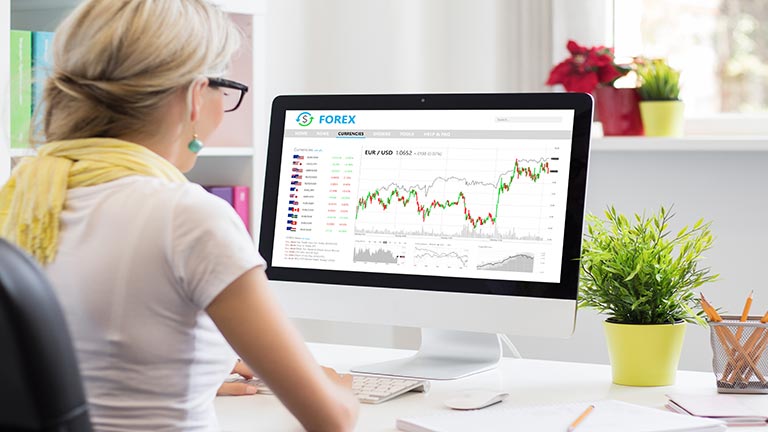Why Backtesting Increases Your Trading Profits

By Dale Gillham
One of the most important rules in trading is to always trade on confirmation not speculation, which is only possible if you understand the risks you are taking with your trading. It is for this reason why I encourage everyone to back-test their trading plans, as it increases the profits you take from the market. Let me explain.
Imagine you have just designed the world’s first parachute and you have decided the only way to test it is to jump out of an aeroplane thousands of metres in the air. What thoughts do you think will be going through your mind just before you take that leap of faith? No doubt, it would be fear if it doesn’t work or elated if it does.
Now let’s suppose you have done extensive testing prior to the moment of taking your leap of faith. You have conducted many simulated jumps in varying conditions, and refined your technique and equipment, so much so, that you are now really confident that you will be able to successfully complete the world’s first attempt to jump from an aeroplane. What would you be thinking now and how would this be different to the option above?
Now I don’t know about you, but if I had to jump out of a perfectly good aeroplane without any training or preparation, I would be thinking that it was downright risky and not a good idea. Especially given that I would have little to no knowledge of whether what I was about to do would work. In comparison, by undertaking extensive testing, I would be much more confident given that I had tested and refined the whole process to such an extent that I was comfortable in knowing that I would be successful.
Understanding the risks you are taking

I am not trying to suggest that the share market is as dangerous as jumping out of a perfectly good aeroplane, although for some traders it can be. What I am trying to say is that many people jump into the share market or attempt to trade highly leveraged markets such as Forex thinking only about how much money they can make without any respect for the risk they are taking. But if you think about it, this is very much like jumping out of an aeroplane without knowing whether your parachute will work with any degree of certainty.
It is common for traders to frequently ask: “How do I trade this way, or in this market?” It’s also common for traders who have already purchased a stock to ask “what should I be doing now?” But when these questions are being asked, it usually means that the person is either losing money or about to lose money.
Now it stands to reason that if someone doesn’t understand the market or instrument they are trading or how to trade it, then they are most likely blissfully unaware of the risk they are taking with their money. The problem with this is that ignorance will cost you a lot of money. You may be lucky once or twice or maybe even a few more times, but let me assure you, just like the parachute jumper who was ill-prepared to jump, you are exposing yourself to a high risk environment and, in the end, you will most likely end up losing most if not all of your money.
Managing your trading risk
So how do you understand the market you are trading, in addition to minimising risk and developing the confidence to achieve success? The best and simplest way I know to achieve this is to back-test or paper trade the market or instrument you want to trade. This is the only way I know that you can develop and test your trading plan, as well as your ability to succeed, while understanding the risks you are taking with your money.
The stark reality, however, is that approximately 20 per cent of traders actually ever back-test or back-test to any real extent, with most preferring the “let’s just jump and see if this thing called a parachute actually opens”. What this means is that the other 80 per cent of traders test their trading plan and their skills, and knowledge by trading their money in the market, which in the majority of cases results in individuals losing some or all of their money.
When asked why someone hasn’t back-tested their trading plan, the most common response is because they can really only test their psychology or their ability to trade when their money is on the line. And while to some extent I would agree with this, what I find the majority actually test is the feeling of being out of control and not knowing what to do when a trade turns sour. When this occurs, all they really experience is the ability to make poor decisions.
If the trade goes well but they are working from a poor trading plan or have based their decisions on poor judgement, then during the trade they tend to develop a false sense of security about their abilities as a trader. Unfortunately, this can cause more losses over time as they continue to use the trading plan or trade a certain way believing that because it worked the first time, it will always work in the future.
It is fairly common when you do something you do not understand properly that then turns sour to experience panic, confusion and stress, all of which are useless to a trader. The more you trade this way, the more you lose sight of how to really trade and how to change your situation.
But when you have a solid trading plan and the skills to implement the plan, it doesn’t matter what happens as the trade unfolds because you will know how to handle it. As a consequence, you will reduce your risk, save time and money and, believe it or not, in the end you will be a much more profitable trader.
Regardless of how experienced you think you are, one of the most important things you need to recognise as a trader is that you should never invest money in any market unless you know with absolute certainty that you have a high probability of success. The no guts, no glory approach to trading is best left to the gamblers of this world.
Backtesting your trading plan
So now let’s consider what you need to do to back-test your trading plan to ensure you succeed.
Step 1: It’s important when you begin backtesting a stock or market, that you have a clearly documented trading plan. In other words, you need to ensure your trading plan is laid out simply, preferably on one page using clearly documented rules for your entry and exit strategy. When determining your trading rules, you need to phrase each one as a question so as to elicit a yes/no answer. For example: Has the stock formed two consecutive closes above a down trend line?
You also need to include your money management rules in your trading plan to ensure you do not take on too much risk. This includes your stop loss strategy, which is the amount you are willing to lose or how far you will allow the stock to fall before you exit. You also need to calculate the level of risk you are willing to take before you enter a trade, as it’s important you do not risk more than 2 per cent of your total capital on any one trade.
Once you have written your trading plan laid out in plain English, you will be able to easily follow it, and as such, avoid any confusion.
Step 2: Now you need to select four stocks with different personalities or from different sectors of the market, as this will allow you to put your trading plan through the ringer, so to speak. For example, you might select a bank, a mining stock, a retail stock and one in telecommunications sector. Given that each of these stocks are from different sectors, you will find they will react differently in how they unfold over days, weeks, months and years, which you will become familiar with as you back-test each stock.
Step 3: You need to go back a minimum of 5 years on each stock you have selected, although my preference is to select 10 years and trade each stock using the rules in your trading plan. This means you scroll back 10 years on your chart and uncover one bar at a time as if you were trading in real time.
With each new bar you uncover, apply your entry strategy to see if the stock fulfills your rules. Once your entry rules are fulfilled, you would complete the money management rules in your trading plan including position sizing, stop loss and risk level. You would then continue to uncover one bar at a time and manage the trade until your exit rules are fulfilled, at which point you would again complete the remaining details in your trading plan.

Step 4: You would repeat this process over the remaining 10 year history for the stock. Once you have completed all of your trades, you would collate your results to determine your win/loss ratio, profit loss ratio and average trade length. From these figures you can then work out whether your trading plan is effective and profitable.
To calculate your win/loss ratio, you simply add up all winning trades and all losing trades and then compare them. For example, if for every five trades, you win three and lose two, your win/loss ratio would be 3:2.
The profit/loss ratio is determined by the profit and/or loss you make on each trade. For example, if you invested $15,000 and sold a month later, taking $17,000 out of the market, you generated a profit of $2,000. You would divide the profit of $2,000 by the initial investment of $15,000 multiplied by 100 to arrive at 13.33 per cent. You need to do this each time you trade.
You then add up all of the percentage profits and divide by the number of trades to arrive at your average profit figure. You then repeat this process for your losses until you arrive at an average loss figure. These figures will tell you how much profit, on average, you make on a winning trade and the average loss you make on a losing trade.
In effect, you are looking for your trading plan to generate a win/loss ratio of 70 per cent or better.
Step 5: Therefore, depending on the results in Step 4, you may need to adjust your trading plan to make it more effective (particularly if you achieved a win/loss ratio of less than 70 per cent) by changing some rule(s) and then repeating Step 3 to back-test your new trading plan.
Step 6: If you achieved a win/loss ratio of 70 per cent or better in Step 4, then repeat Step 3 and 4 on the remaining 3 stocks. Once again, if the win/loss ratio is less than 70 per cent, then you need to revert to Step 5.
Step 7: Once you have achieved consistent and profitable returns from backtesting these stocks, you are ready to trade in the market using this trading plan.
The reality of why backtesting increases your profits
Over the years I have seen trading plans back-tested that achieved great results only to find that when I checked the trades the person was not actually applying the rules they had set correctly. Either they did not apply the analysis or the rule(s) correctly or they ignored or bent the rules. However, when backtesting a trading plan, it’s important that you check yourself or have someone else check your plan to ensure you are following the rules you laid down.
Now I know some of you will be saying to yourself that this will take too much time to do and that while you are backtesting you could be making money by actually trading. But let me assure you that if you take the time to do this exercise, not only will you fine tune your trading plan, you will fine tune your skill and abilities to trade. It will also give you much more confidence in your trading plan and confidence to stick to it if things turn sour.
But the real benefit is that your journey to becoming a successful trader will be much quicker and more profitable. If you decide not to back-test your trading plan, your journey will be much slower and harder, and you will be less profitable. So the question you have to ask yourself, is which option would you prefer?
In reality, if you fail to back-test your strategy, then your chances of achieving long term consistent success in the share market are greatly diminished. I have lost count of the number of traders I have met who tell me they get inconsistent returns or that they have been profitable for six months or more only to become unprofitable.
The main reason for this is that they generally do not have enough knowledge, and have not fine-tuned their skills to a level where they can be totally confident in how they trade. It stands to reason that if you want to be better than the average person in the share market, you need to do what the average trader does not do, and that is test, and re-test your skills and trading plan. Trust me when I say, the time you put into this will be repaid tenfold.
Others who read this also enjoyed reading:






